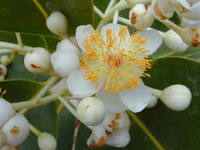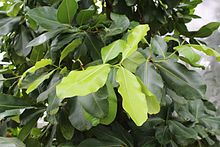Punnaga Tree
Punnaga or Calophyllum inophyllum is a large evergreen plant, commonly called Alexandrian laurel, ball tree, beach calophyllum, beach touriga, beauty leaf, Borneo-mahogany, Indian doomba oil tree, Indian-laurel, laurelwood, red poon, satin touriga, and tacamahac-tree. It is native from East Africa, southern coastal India and Australia.
Calophyllum inophyllum is a low-branching and slow-growing tree with a broad and irregular crown. It usually reaches 8 to 20 m (26 to 66 ft) in height. The flower is 25 mm (0.98 in) wide consisting of four to 15 flowers. Flowering can occur year-round, but usually two distinct flowering periods are observed, in late spring and in late autumn. The fruit (the ballnut) is a round, green drupe reaching 2 to 4 cm (0.79 to 1.57 in) in diameter and having a single large seed. When ripe, the fruit is wrinkled and its color varies from yellow to brownish-red.
Besides being a popular ornamental plant, its wood is hard and strong and has been used in construction or boatbuilding. Traditional Pacific Islanders used Calophyllum wood to construct the keel of their canoes while the boat sides were made from breadfruit (Artocarpus altilis) wood. It is sometimes used for backs and sides of entry-level acoustic guitars.
The seeds yield a thick, dark green tamanu oil for medicinal use or hair grease. The nuts are dried before cracking, after which the oil-laden kernel is removed and further dried. The first neoflavone isolated from natural sources (1951) was calophyllolide from C. inophyllum seeds.
The Mavilan, a Tulu-speaking tribe in north Kerala in India, use the bark to make a powder that they mix with water and apply it to plants affected by a type of plant disease caused by water that they call neeru vembu.
The sap of the tree is poisonous and is used to make poison arrows in Samoa. The mature fruit is poisonous enough to use as rat bait.
The fatty acid methyl esters derived from C. inophyllum seed oil meets the major biodiesel requirements in the United States (ASTM D 6751), and European Union (EN 14214). The average oil yield is 11.7 kg-oil/tree or 4680 kg-oil/hectare. In the northwest coastal areas of Luzon island in Philippines, the oil was used for night lamps. This widespread use started to decline when kerosene became available, and later on electricity. It was also used as fuel to generate electricity to provide power for radios during World War II.
The tree is regarded as sacred in some Pacific islands because of its excellent growth in sandy soil as shade tree and many uses. The 1889 book 'The Useful Native Plants of Australia records that "During a debate on the Pearl Fisheries Bill in the Queensland Assembly, a clause was specially inserted to protect trees of this species at Thursday Island. A fine of £10 is inflicted on any person who cuts down or injures this or a cocoa-nut tree, or any other tree bearing edible fruit. This clause is, of course, in the interest of the aboriginals."
The flower of Punnaga is sacred to Lord Vishnu, forming his garland. Afragrant flower it adorns the hair goddess Lalitambika in the Lalitha sahasram. The flower is used in worship of lord Vishnu as a medicinal Punnaga is widely used for many formulations in Ayurveda. It is administered for Raktapitta, Rakta srava, Raktatisara etc. It is described by Charaka, Vagbhatta etc and its oil is extracted and it is widely used.

